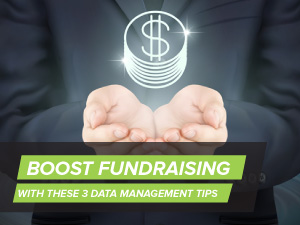
As a nonprofit, a lot of your time and energy goes towards fundraising each and every day. These fundraising campaigns are the foundation that funds your mission and the steps you need to take to achieve your greatest goal.
Therefore, enhancing your fundraising initiatives is incredibly important for your organization’s success.
Luckily, there are some fundraising tips and tricks you can use to get the most out of your nonprofit’s fundraising, generally centering around your data. Donor data, when saved in your nonprofit’s CRM, can be leveraged to build better relationships with your supporters, augmenting your fundraising. The tips and tricks we’ll cover in this article include:
- Personally tailor outreach to supporters.
- Compile affinity scores to guide fundraising asks.
- Learn how to augment each and every gift.
Ready to learn more about data management and how to better leverage it for more effective fundraising? Let’s get started.

1. Personally tailor outreach to supporters.
When was the last time you received a note with the salutation, “To whom it may concern”? How did you feel receiving it? You probably felt like whoever sent it just mass-mailed the message. It’s not personal.
If you do that to your donors, you’re limiting the potential relationships you can build because supporters don’t feel that you truly care about them.
Using donor data to personalize your outreach is the first step to better fundraising.
The first step is to pull the personal details from your donor database, such as the donor’s preferred name. However, you can take personalization a step further by segmenting donors using data like:
- A donor’s connection to the cause. By knowing what originally drew donors to your organization in the first place, you can ensure that the stories you tell will resonate with them.
- A donor’s previous gift amounts. To ensure that you don’t ask too much or too little, pay attention to past gift amounts (but don’t be afraid to pursue upgrades). What you don’t want to do is encourage significant downgrades, or alienate a donor with an astronomical ask.
- A donor’s interests. Take note of the personal interests supporters have, then mention those interests in your communications to draw their attention and make connections.
Taking into consideration the motivations and interests of your supporters is a great way to start building relationships and making deeper connections. If you’re looking for a software solution to store all of this important data, Bloomerang’s donor database guide can help you pick the best solution for your needs.

2. Compile affinity scores to guide fundraising asks.
Affinity scores, as we talk about it here, refers to the research you conduct about each supporter that’s not collected directly from the supporters themselves. The two important donor metrics we’ll touch on are engagement and generosity.
Donor engagement is one degree away from the direct metrics from your supporter. It’s a compiled metric that takes into consideration the various touch-points you’ve had with a supporter.
Compiling these into a single metric can help you get a good overarching idea of how engaged your supporter is. Engaged supporters are more likely to give. By measuring engagement, you can save donors from lapsing and boost your retention rates, increasing your fundraising amounts.
Donor generosity data is primarily taken from the prospect research and wealth screening your nonprofit can conduct about each supporter. This research can better inform where your donors are in their gift ranges.
Measuring donor generosity can greatly inform gift range charts for major campaigns. Plus, it can help inform your fundraising asks. If you ask for too much, you’re more likely to receive a “no,” and if you don’t ask for enough, you’re not maximizing your donation amounts.
If you’re interested in the other data that can inform your nonprofit’s decisions, DonorSearch’s donor analytics guide is a great resource to learn more.

3. Learn how to augment each and every gift.
Can you imagine what would happen if all of the donations you received were increased by just $1 or $5? This small increase would add up and could make a huge difference! This may not be an easy achievement, but the idea is that maximizing each individual donation will make a big impact on your overall fundraising amounts.
The first step is to invest in the right fundraising software. When you have the best fundraising solutions, such as a great CRM, corporate giving, and donation form software, you can see more opportunities for these augmentations.
For instance, consider the following opportunities:
- Retaining more donors. It’s rare that new donors will give high donation amounts. Instead, retaining donors will encourage them to give more and more throughout the years. Plus, it costs less to keep donors than it does to acquire new ones, helping you save money.
- Matching gifts. Matching gifts are a form of corporate philanthropy in which employers support their employees’ contributions to nonprofits by financially matching the donations they made. Make sure your supporters know their gift could be doubled and encourage them to check their eligibility.
- Volunteer grants. Volunteer grants are another form of corporate philanthropy where employers financially match the time an employee gives volunteering for a nonprofit. Generally, employers have rules about the match amount they’ll provide for certain hour requirements. Learn more about volunteer grants here.
Maximizing gifts as much as possible helps your nonprofit raise more without acquiring too many more donors. Instead, your focus remains on reaching your full potential.
Whether you’re focusing on acquiring new donors or reaching out to your existing donor base, your nonprofit should work hard to get the most out of your fundraising initiatives. Refining your strategy with these three tips is a great place to start. Good luck!